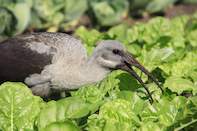Biological control methods of organic pest control include a wide variety of options, including pheromones, repellents and natural enemies as well as biological ‘toxins’.

When there is an excess of one species of insect, it is often an indication that the balance is disturbed. A pest can, therefore, be seen as nature’s way of showing where possible changes can be made on the farm. The insects we see as ‘pests’ often are the prey of other beneficial insects and it is important to know, protect and allow these beneficial insects to multiply.
Plants that attract beneficial insects are the Asteraceae family (like sunflowers), clover, common yarrow (Achillea millefolium), buckwheat and many more. Examples of beneficial insects are the larva of the ladybird. It is a spiky, snail-like worm that can cause as much damage to pests as the bug itself.
Lacewings belong to the Neuroptera order (family: Chrysopidae). Aphids form an important part of their diet, but other insects like mites, thrips, whiteflies and leafhoppers as well as insect eggs are eaten.
A common species that attack aphids on wheat is the hoverfly (Eupeodes corollae) which with its yellow and black behind resembles bees or wasps.
There are companies that breed and sell beneficial insects like ladybirds (Chilocorus nigritus and Cryptolaemus montrouzieri), and the parasitic wasps Aphytis lingnanensis and Coccidoxenoides perminutus.
These insects thrive on grapevine mealy bugs and red scales. The following is an overview of common pests and how to control them organically.
Red Spider Mite
The insect is very small. It spins a web at the bottom of leaves and sucks out the plant juices. The red spider mite thrives in hot conditions and can be controlled by mulching or spraying the bottom of the leaves with water.Aphids
Mix water and green sunlight soap to form a light foam. Never use dishwashing liquid or detergents containing chemicals, but Sunlight Liquid is safe to use. Dip a sponge or small cloth in this soapy water and carefully wipe the aphids from the plants. Repeat the process three times at three-day intervals. Ladybirds also feed on aphids and usually live in the flowers of carrots, fennel and coriander.Ants and Termites
These insects do not eat plants but sometimes are carriers of aphids. Termites belong to another family and eat wood such as mulch, tree trunks and even furniture and wooden floors. Grind dry chilli to a fine powder and sprinkle it in the areas where the ants are active.Snails
Snails are active and feed at night. They like cool, moist places and hide under garden litter. Keep the production area clean of dead leaves and other litter. Sprinkle ash or crushed eggshells around plants, keeping the snails away.
The sharp eggshells damage the snails’ soft bodies. Plain table salt is also deadly for snails and other "soft-bodied" pests, but too much of it can harm the fertility of the soil, warns Dr Victor Whitlock, an agricultural consultant.
Nematodes
Nematodes are small parasitic worms that extract the juice from the roots of plants. Their eggs form nodes on the roots which slow down the growth of plants. These nodes can also cause the plants to die. Mulch, compost and organic fertilizer produce organisms which feed on nematodes.
The summer flowering plant, African marigold can be planted as a cover crop as it secretes a substance through their roots that is poisonous for nematodes. It can also be harvested during flowering and sprayed as an extract.
A strain of the bacterium Streptomyces feeds on the chitin layer of soil pathogens such as nematodes and phylloxera and is a registered drug for use against nematodes, advised Bob Cantisano of Organic Ad Advisors.